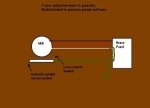- 325
- 6
- 0
- Location
- Linden, TN
View attachment ground.pdf@wheeler605 Yours is pictured MEP803a, The thread Is for MEP003a
Steel Soldiers now has a few new forums, read more about it at: New Munitions Forums!

Still looking for info on this.Any documented safety incidents associated with the grounding/neutral bonding issues?
Jerry

Munchies, I see what you're saying but it kind of contradicts the above post.Andy and the rest of you guys. I would have jumped into this discussion earlier, but I have been out of town.
GROUNDING!!!!!!!!! You DO NOT NEED to disconnect the neutral ground of the generator. You also DO NOT NEED to drive a ground rod at the generator! As a matter of fact, you should not drive a ground rod at the generator. The NEC states that only one earth ground shall be installed. This was done at your main service panel when your house was wired and built. You do not drive a second ground rod at the generator, the military does this because these sets are the main power source out in the field. They are not the main power source in your home.
To install them properly, you should be running 4 wires from the generator to the transfer switch/hook-up spot in your house. Two of those wires should be the two "hot" legs of the generator, one wire should be the "neutral" from the generator, and the last wire should be a continuous unbroken ground going back to the grounding bus in the main panel. You could also do as Ike suggested and isolate the neutral bond at the frame of the generator and then drive a second ground rod. This is safe to do, but depending on your electrical inspector you still may have a tough time getting it to pass muster, because as I've stated the NEC specifies only one (1) ground rod shall be driven!
The reason for only having one ground rod is this. If you look at your main electrical panel you will notice that the neutral buss and the ground buss are bonded together, they are essentially (electrically) the same buss. If you drive a ground rod at the generator and do not remove the neutral bond, you now have two (2) pathways for the neutral current to get back to the generator, the neutral wire and the earth ground because of the second ground rod you drove....this is a big NO NO!!!! The current will parallel the two pathways and now the earth ground becomes a current carrying conductor, and as per the NEC this as a violation. The ground shall NEVER be a current carrying conductor. If you feel better doing as Ike sugested, you can go to the trouble of disconnecting the neutral bond on the generator and driving a ground rod, but if you want to go according to the NEC, that is still not a proper installation, is it safe? Yes!
If you have not hooked up the generator yet, save yourself the trouble and hassels, and just run the 4th wire (the ground) back to your panel and do it the easy way. If you have 4 wires going from the generator to your house already, leave the ground wire hooked to the generator frame and remove the one going to the second ground rod (just be sure the neutral bond is connected to the frame).
